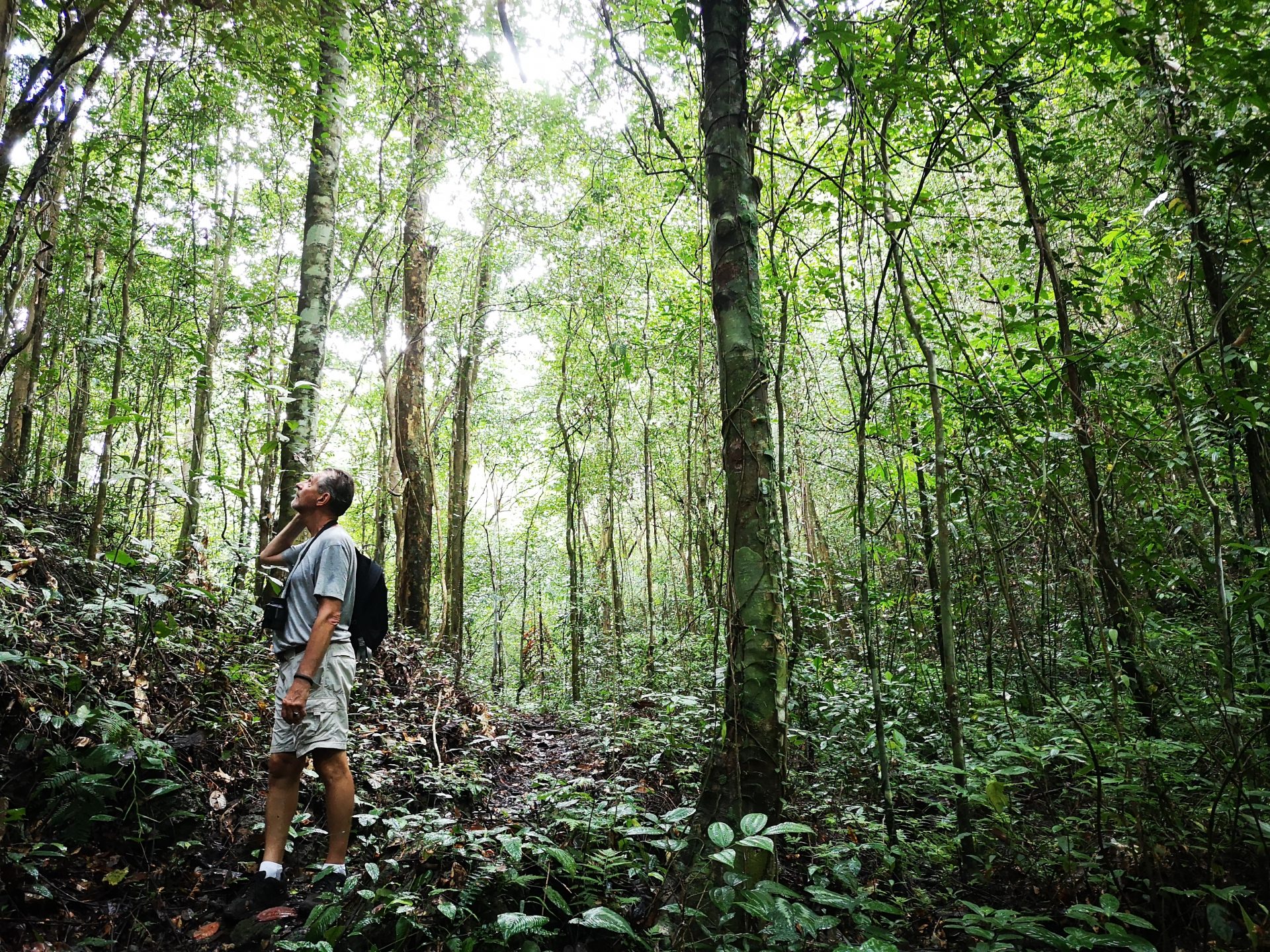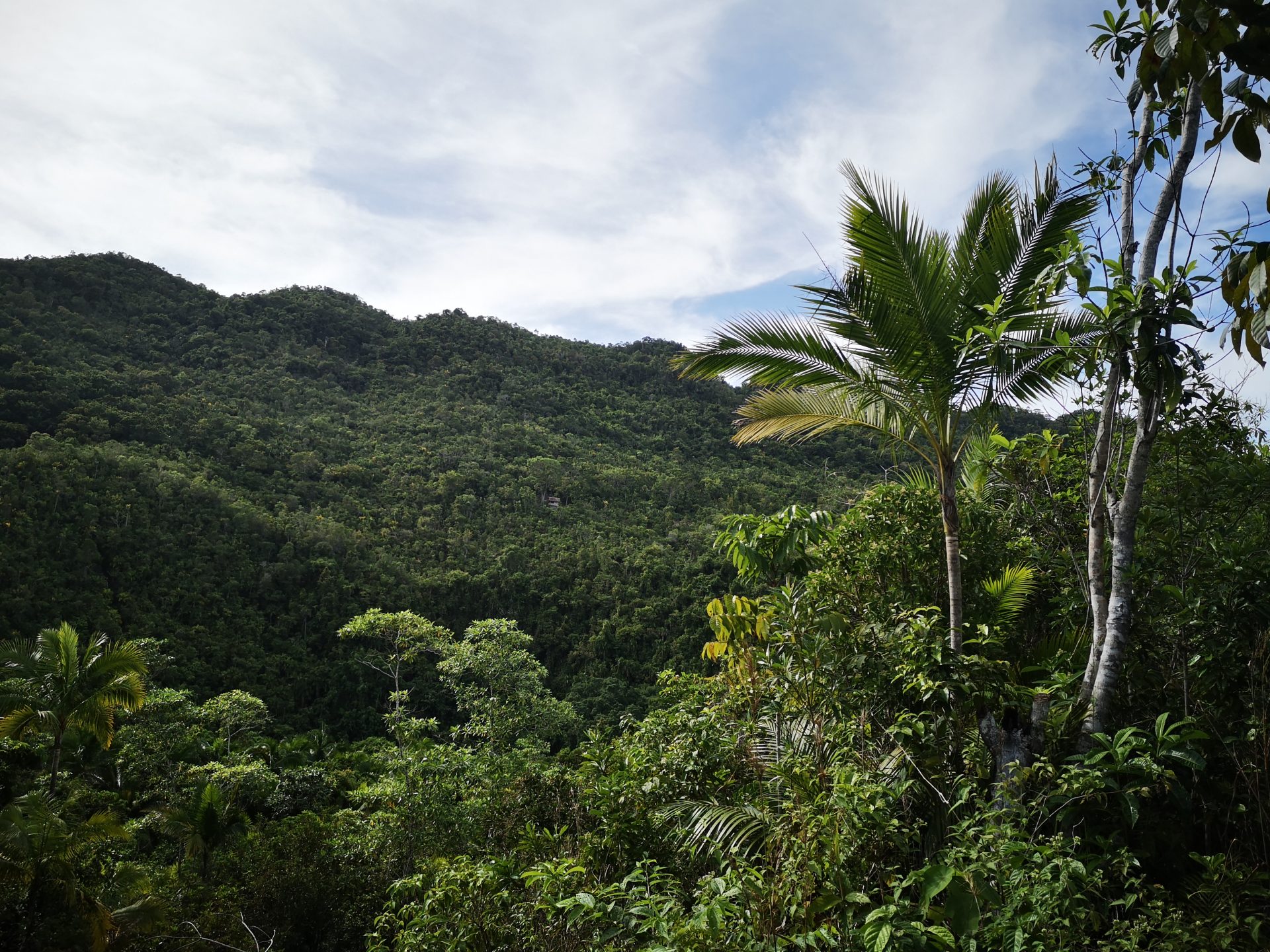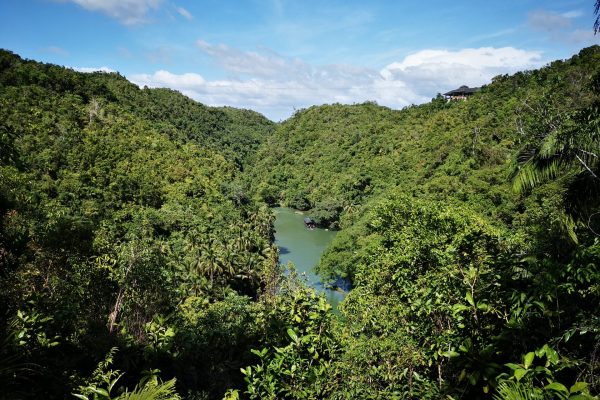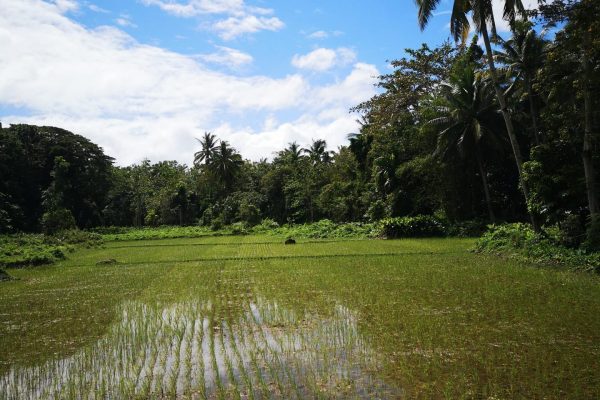A fter a challenging day travelling from the Camotes Islands, we finally reach the southerly island of Bohol in the Eastern Visayas and after a few beers and comfort food, tensions ease and we look forward to tomorrow. We will explore the beaches of Panglao Island, reached by a causeway in the south of Bohol. The Rough Guide boasts that the white sandy beaches are beautiful.
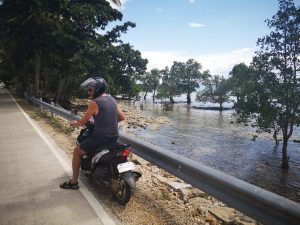 Our first full day in Bohol is underwhelming. We hire a motorbike and explore the coast and find it lacking. In our opinion, the beaches are either too crowded, over developed or too shallow to swim. According to the hugely popular online travel guide, Culture Trip, Alona beach is the place to be. I will be taking all advice from this site now with a pinch of salt, as Alona is quite possibly the most hideous beach I have ever visited. A tiny strip of sand full of people and surrounded by hotels, shops and restaurants. It’s frequented by touts for tours and massages and I’m hoarse with constantly repeating ‘No’. Disappointed, we return to our guesthouse. On the way we spot a sign for a ‘vantage point’ bar. We head up, have a G&T and enjoy the view across the island. Things are looking up again.
Our first full day in Bohol is underwhelming. We hire a motorbike and explore the coast and find it lacking. In our opinion, the beaches are either too crowded, over developed or too shallow to swim. According to the hugely popular online travel guide, Culture Trip, Alona beach is the place to be. I will be taking all advice from this site now with a pinch of salt, as Alona is quite possibly the most hideous beach I have ever visited. A tiny strip of sand full of people and surrounded by hotels, shops and restaurants. It’s frequented by touts for tours and massages and I’m hoarse with constantly repeating ‘No’. Disappointed, we return to our guesthouse. On the way we spot a sign for a ‘vantage point’ bar. We head up, have a G&T and enjoy the view across the island. Things are looking up again.
The next day we take the motorbike west along the coast and north into the interior of Bohol. We will avoid Bohol’s number two tourist trap, a Tarsier Sanctuary. It may be a rescue centre for these small, large eyed, nocturnal monkeys, but we don’t tend to enjoy seeing any creature in captivity, prefering to leave our nature spotting to luck, out in the wild. Our destination is the ‘Chocolate Hills’, Bohol’s number one tourist destination. The ‘hills’ are forty metre high, brown mounds of coral and limestone and there’s an incredible two thousand of them. Armand doesn’t want to go to the Chocolate Hills, fearing that it will be another crowded and underwhelming spectacle. I want to see them as they are a natural wonder.
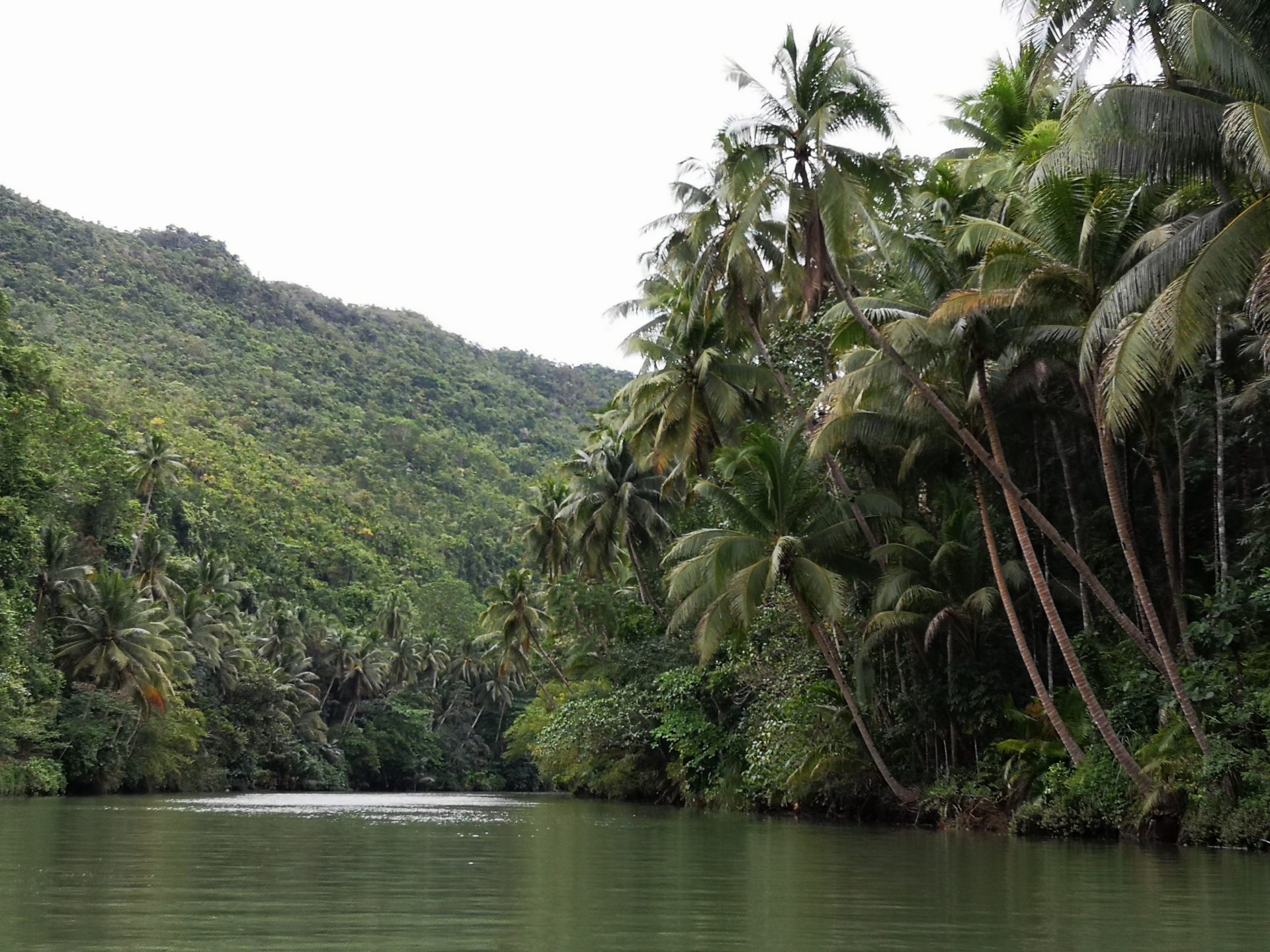
It’s clear that we have made the right decision to explore the interior. The countryside is beautiful. Verdant tropical jungle. We take a turn off the main road and find the green and tranquil tidal river Loboc. It’s so peaceful, we stop for a coffee and conclude that we have been staying in the wrong area. We need to get away from the crowded beaches and stay in the jungle.
There’s some accommodation recommended in the Rough Guide that’s nearby and we go and check it out. Amusingly called Nuts Huts, the small site is located down a 1km potholed and muddy track and I have to get off the motorbike several times and walk rather than risk bouncing off the back. We reach a steep set of concrete steps which descend through vegetation to a large deck built into the side of the hill. This is the reception and the restaurant for Nuts Huts. The accommodation is located below beside the river. We both know immediately that we have to stay here. The Huts are affordable, but how do we get our heavy suitcases there? The track is too rough to walk with cases from the bus stop on the main road and a taxi ride would be too expensive. There’s the steps too, we’d hurt our backs! We mention our problem and are told that a beautiful way to arrive is by boat along the jungle edged river. How many times do you get the chance to arrive at your accommodation like that? It’s a dream. I have visions of the film African Queen. We can take a public bus to Loboc and get off at Sarimanok boat station and drift down to the Huts, total cost £6 each. Jackpot. We book four nights and stay on the restaurant deck for a beer.
It’s 2.30pm and the Chocolate Hills are still 30km away. About an hour by motorbike. Armand is still reluctant, but agrees to go. I say that we won’t stay long and so will be back at our guesthouse before it gets dark. The journey continues to be quite lovely, passing rice terraces and farmland. After the estimated hour we find the Chocolate Hills viewpoint. Yes it’s busy, yes it’s a tourist hotspot with crowds of coach parties, but it doesn’t distract from the fact that the hills are truly intriguing. They are strange formations and water vapour seems to rise and sweep around them. I say to Armand that I think it’s a better spectacle than the temples at Bagan. He agrees and is more impressed than expected.

We soak up the sight for 20 minutes before the heavens open. A torrential downpour sends everyone racing down to the carpark for cover. We wait. It’s now 4.30pm. Armand gives me one of those looks – Now look what a fine mess you’ve got me into Stanley. We are at least 2 ½ hours motorbike ride from our base. We are on a tiny motorbike. We have no waterproofs. It has come over extremely gloomy and the sun will set at 5.30pm. We will be riding in the dark and the rain.
I know Armand is not entirely comfortable with the idea of our journey home in the rain on the motorbike, but he hides these doubts from me and puts on a bravado which inspires confidence. We purchase two cheap, thin, yellow plastic ponchos from a souvenir shop and whilst we look ridiculous, we feel instantly warmer. We agree to take it slow and steady and stop if we have any doubts.
Thankfully the rain stops. Just the dark and wet muddy roads to manage. We are splashed by a couple of lorries but the ponchos work well. A large bug hits my cheek. It’s a real strike. Our bottoms, knees and backs ache. It’s going to be seven hours on a motorbike today. We agree that we will never do more than four hours a day on a motorbike ever again.
 The ride culminates in the busy port town of Tagbilaran City.
The ride culminates in the busy port town of Tagbilaran City.
Armand negotiates crazy third world drivers, tricycles, (which are public transport motorbikes with covered sidecars, all with their own chosen line from the Bible painted on the back), lorries, cars, tuk tuks, roadworks and jeepneys (jeeps that have been extended into long single decker buses with fantastic and varied paint jobs). Armand does grand. Arriving back at our guesthouse, our bodies are wrecked, but in one piece. I give him a huge hug. He has cold feet and hands and heads for the shower. We order comfort food, pop some painkillers, listen to the wail of the tsunami/earthquake siren that’s being tested and finally crash into bed and sleep surprisingly well.
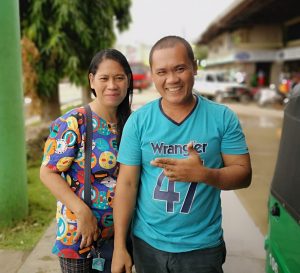 It feels good to be travelling to Nuts Huts. We take a tuk tuk owned by Eric from our guest house in Panglao to the bus station. We collect Eric’s wife Lorna on the way and she is interested in where we are from and where we are travelling to. She helps me with my pronunciation of some of the islands we wish to visit. As we approach the city, we are told that we ‘are family’. It appears Eric’s tuk tuk is not officially allowed into the city with paying customers. We happily agree. We like this couple very much. At the check point, the police are thankfully more interested in an incident of some nature than Eric’s illicit business.
It feels good to be travelling to Nuts Huts. We take a tuk tuk owned by Eric from our guest house in Panglao to the bus station. We collect Eric’s wife Lorna on the way and she is interested in where we are from and where we are travelling to. She helps me with my pronunciation of some of the islands we wish to visit. As we approach the city, we are told that we ‘are family’. It appears Eric’s tuk tuk is not officially allowed into the city with paying customers. We happily agree. We like this couple very much. At the check point, the police are thankfully more interested in an incident of some nature than Eric’s illicit business.
The bus station is next to the mall and I go in search of insect repellant, local rum, and a cashpoint, leaving Armand with the suitcases across from a Dunkin Donuts. I can guess where he will visit whilst I’m away. Chores complete and doughnuts consumed, we find our bus.
It’s a rickety thing. Windows open for Aircon. It’s destination is Tubigon on the opposite side of the island via Carmen which is just a bit further than we want to go. It should stop for us at Sarimanok boat station. We put the bags in the storage hold and get on. It will leave when it is full and we are pleased to see it’s quite packed already. Not long to wait. Tickets are purchased on the bus on the way. It’s just 50p each for the 40 minute ride. Stupidly, we have both spent our ‘small money’ which is requested by the conductor. He won’t accept our larger notes. I manage to scrape together my fare of 30 pesos and Armand offers a US dollar for his fare. The conducter accepts saying ‘no change’. He is happy and will pocket a few pence from the deal.
The journey is swift and comfortable. A couple of passengers ask where we want to go and as we approach our stop, they kindly call to the conductor and driver. We alight opposite a tiny hut above the river. We haven’t booked this journey, so we’re amazed that there’s a woman at the hut, who greets us, relieves us of 300 pesos (almost £5) and directs us down to the river where there is a small boat ready to take us up river. The trip is such a pleasure. There’s dense jungle either side of the green water and ahead of us the jetty for Nuts Huts. This travel day has gone well with no incidents or arguments and it’s quite possibly the nicest way I’ve ever arrived at accommodation.
Leaving our cases by the river where the Huts are located we walk the first set of 120 steps to the reception deck above. There’s a total of 280 steps from the Huts to the top of the ridge. Just three weeks ago, I couldn’t have taken one of those steps, having contracted Chickungunya virus from a mozzie in Myanmar. I’m still not as sure footed and strong as I was preceding that attack and I now need to start working my muscles again. I determine to use these steps over the four day stay here to aid my recovery back to form.
Our hut is made from local natural materials, timber, bamboo and palm with a thatched roof. It’s raised with a bamboo ladder to a small balcony. Inside is a basic wet room with the usual cold shower straight from the pipe with two settings, on or off. A manual flush toilet – there’s a bucket of water with a saucepan sized plastic ladle to use to flush. No soundproofing, so it’s again pretty much like camping. There’s a group of half a dozen huts, but this place seems only to attract guests who are respectful. There is a ‘quiet policy’ after 10pm. The only daytime disturbance appears to be from 11 to 3pm when the occasional floating restaurant goes by on the river, complete with Korean tour parties and cheesy entertainment. We hear tunes originally by the Carpenters and Andy Williams from the boats and hideously, Rudolph the Red Nosed Reindeer. I’m not impressed. After years in retail, I’m attempting to avoid Christmas this year.
At night, our surroundings are alive. Large but surprisingly unaggressive black ants join us on the balcony. There’s the constant rattle of insects overlaid with a frog whose croak is more like a deep duck call whistle. Two owls in the distance. A nocturnal bird with a whirling, escalating scale of a song. The noise of the insects sometimes lulls and then increases again. I’d love to know why. Then a loud crack similar to an axe being taken to a tree, followed by a soft thud upon spongey ground. A palm branch or coconut has fallen. During the evening and all through the night it rains gently and the sound on the thatch and the deck is comforting.
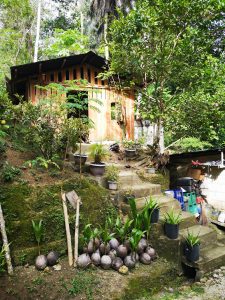 In the morning we walk through the jungle to Tigbao bridge, something similar you would see in Madison County. We pay the equivalent to 25p to be ferried across the river in a tiny canoe and scramble up the bank on the other side to find a path to a waterfall. We want to swim up to the falls, but the current is too strong. Returning to the path cut through the dense vegetation, we start a slow, steep ascent. A large, vivid, turquoise blue bird with white tips on its wings flies past. It’s quiet. Apart from the odd homestead, we do not see a soul.
In the morning we walk through the jungle to Tigbao bridge, something similar you would see in Madison County. We pay the equivalent to 25p to be ferried across the river in a tiny canoe and scramble up the bank on the other side to find a path to a waterfall. We want to swim up to the falls, but the current is too strong. Returning to the path cut through the dense vegetation, we start a slow, steep ascent. A large, vivid, turquoise blue bird with white tips on its wings flies past. It’s quiet. Apart from the odd homestead, we do not see a soul.
As with Myanmar, living in the Philippines for the many is hard. Homes are basic, cobbled together from any available material, a hodge podge of levels and construction methods, bare breeze blocks, timber, corrugated metal roofs. Livestock and pets are tethered outside. Pigs are kept in small pens. Dogs bark as we pass. Hens peck around in the leaves and every house seems to breed cockerels for fighting. This brutal ‘sport’ is clearly still a favourite weekend entertainment. We are told at Nuts Huts that it’s only a 6km hike to the bridge, but it feels longer. It’s tough. It’s hot. We are out for four hours, finally reaching a road where we flag a colourful jeepney bus and for 20 pesos (25p) we are taken the short but welcome 3km down the main road to the muddy and potholed track which returns us to our hut.
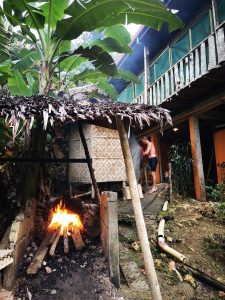 As a treat, we book the steam room, a bamboo hut with a boiler fueled by a log fire. I’m pleased with myself. Mozzie virus almost over. I’ve managed a good amount of walking today and 640 concrete steps. I’m starting to finally feel that I’m getting my mojo back. Day two at the river is spent relaxing with more step climbing. 1080 concrete steps climbed by the end of that day followed by another 1000 on day three.
As a treat, we book the steam room, a bamboo hut with a boiler fueled by a log fire. I’m pleased with myself. Mozzie virus almost over. I’ve managed a good amount of walking today and 640 concrete steps. I’m starting to finally feel that I’m getting my mojo back. Day two at the river is spent relaxing with more step climbing. 1080 concrete steps climbed by the end of that day followed by another 1000 on day three.
Whilst attempting to find the name of the large blue parrot like bird we saw on our walk, I stumble upon a website for Bohol’s only national park, Rajah Sikatuna Protected Landscape. A birding and hiking destination that appears to be a closely guarded secret. It’s not marketed in any guide book, tour or billboard in Bohol. This is incredible and a tradegy if its claim to be the widest remaining forest of the Philippines, is true. It’s only 30 minutes away from us by public bus.
After breakfast, a bit late in the day for birdwatching, we walk up the track to the main road where we flag a passing bus. The public bus system works well – flag down a passing bus from anywhere on the main road, checking the front sign to ensure it is going in the correct direction for your destination. Simply get on, sit down alongside the locals and at some point in your journey a conductor will ask you where you are going and you pay the fee. No air con, just open windows. The cost is low. We travel 30 minutes, about 20km for 30 pesos, 25p. The conductor calls out the villages and we alight at Bilar market. It’s a busy little village and the road is being relaid in concrete. The market is scruffy but there’s incredibly the cleanest public toilets. There’s even a proper flush. Amazing what you appreciate after 40 days of travelling in the third world. We are serenaded by a group of carol singers again. I endure. They are kids.
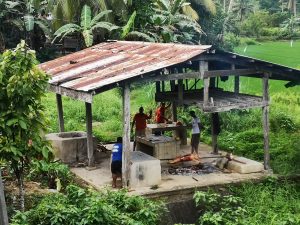 We walk past rice terraces, gardens full of cockerels and homesteads cooking Lechon, (spit roasted pigs that are ordered for celebrations and gatherings), before reaching the entrance to the park. The access road is treacherously slippery, covered in moss. It’s 100 pesos each to enter and 500 pesos plus tip, for a guide for bird watching. So we pay at total equivalent of £15 and meet Joving who will take us out for 21/2 hours. We fear that we may not see anything, arriving at noon to such a dense forest, but walk quietly through the damp and leaf littered path, over python like tree roots and under the native trees. The tropical forest is dark and dripping. I never thought I’d be a twitcher, but every time we travel to a country, we now seem to go bird watching and I enjoy the stalking.
We walk past rice terraces, gardens full of cockerels and homesteads cooking Lechon, (spit roasted pigs that are ordered for celebrations and gatherings), before reaching the entrance to the park. The access road is treacherously slippery, covered in moss. It’s 100 pesos each to enter and 500 pesos plus tip, for a guide for bird watching. So we pay at total equivalent of £15 and meet Joving who will take us out for 21/2 hours. We fear that we may not see anything, arriving at noon to such a dense forest, but walk quietly through the damp and leaf littered path, over python like tree roots and under the native trees. The tropical forest is dark and dripping. I never thought I’d be a twitcher, but every time we travel to a country, we now seem to go bird watching and I enjoy the stalking.
It’s exciting and we cover a lot of ground in total silence. 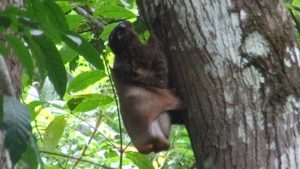 It’s not long before Joving is pointing out birds, tiny frogs and flying lemurs. The latter are nocturnal and hang from trees, sloth like. Their heads are a similar shape to a squirrel with large eyes, their bodies rotund like a dark brown teddy bear.
It’s not long before Joving is pointing out birds, tiny frogs and flying lemurs. The latter are nocturnal and hang from trees, sloth like. Their heads are a similar shape to a squirrel with large eyes, their bodies rotund like a dark brown teddy bear.
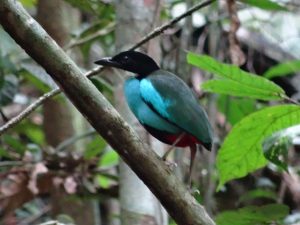
We spot a succession of birds including a Black Faced Coucall and a rare Azure Breasted Pitta, with blue and red colouring. There are Tarsiers here, but these small nocturnal monkeys with large eyes can only be seen on a night safari. After the hike we’re tired, but satisfied and travel back to the huts for supper.
We will be leaving for Malapascua Island tomorrow imagining Christmas on a warm beach and snorkelling in gin clear water.
That was not going to happen……..
